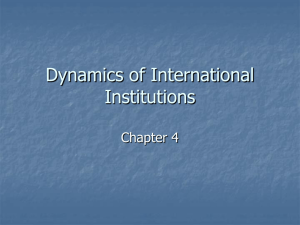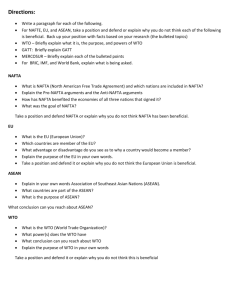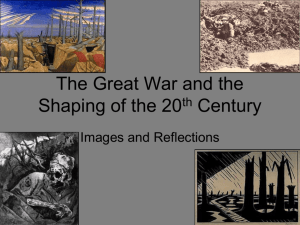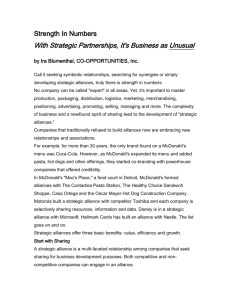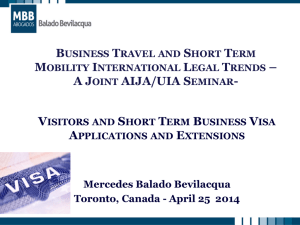Document 10585807
advertisement
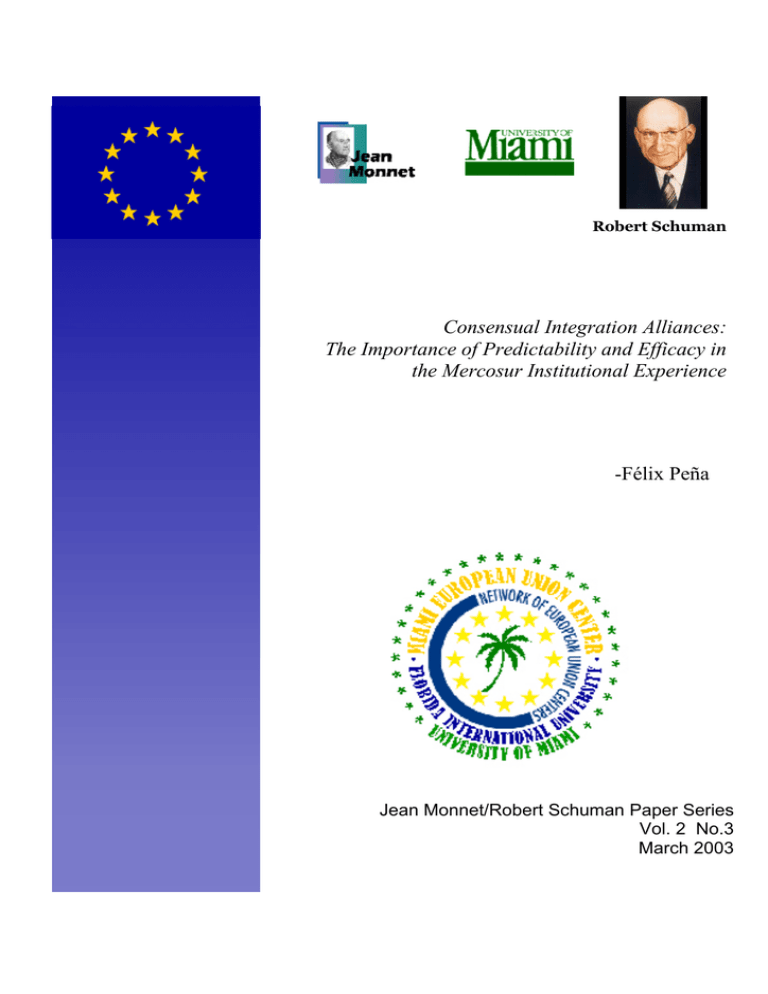
Robert Schuman Consensual Integration Alliances: The Importance of Predictability and Efficacy in the Mercosur Institutional Experience -Félix Peña Jean Monnet/Robert Schuman Paper Series Vol. 2 No.3 March 2003 The Jean Monnet/Robert Schuman Paper Series The Jean Monnet/Robert Schuman Paper Series is produced by the Jean Monnet Chair of the University of Miami, in cooperation with the Miami European Union Center. These monographic papers address issues relevant to the ongoing European Convention which will conclude in the Spring of 2003. The purpose of this Convention is to submit proposals for a new framework and process of restructuring the European Union. While the European Union has been successful in many areas of integration for over fifty years, the European Union must take more modern challenges and concerns into consideration in an effort to continue to meet its objectives at home and abroad. The main issues of this Convention are Europe’s role in the international community, the concerns of the European citizens, and the impending enlargement process. In order for efficiency and progress to prevail, the institutions and decision-making processes must be revamped without jeopardizing the founding principles of this organization. During the Convention proceedings, the Jean Monnet/Robert Schuman Papers will attempt to provide not only concrete information on current Convention issues but also analyze various aspects of and actors involved in this unprecedented event. The following is a list of tentative topics for this series: 1. The challenges of the Convention: the ability to govern a supranational Europe or the return to intergovernmental cooperation? 2. How will the member states figure in the framework of the Convention? 3. The necessity to maintain a community method in a wider Europe. 4. Is it possible for the member states to jeopardize the results of the Convention? 5. The member states against Europe: the pressures on and warnings to the Convention by the European capitals. 6. Is it possible that the Convention will be a failure? The effects on European integration. 7. Similarities and differences between the European Convention and the Philadelphia Convention of 1787. 8. The role of a politically and economically integrated Europe in the governance of the world. 9. How important is European integration to the United States today? 10. The failure of a necessary partnership? Do the United States and the European Union necessarily have to understand each other? Under what conditions? 11. Is it possible to conceive a strategic partnership between the United States, the European Union and Russia? 12. Russia: a member of the European Union? Who would be interested in this association? Miami European Union Center University of Miami 1531 Brescia Avenue Coral Gables, FL 33146-3010 Phone: 305-284-3266; Fax: 305-284-4875 E-Mail: jroy@miami.edu Webs: www.miami.edu/international-studies/euc www.euroy.org; www.miamieuc.org Jean Monnet Chair Staff: Joaquín Roy (Director) Aimee Kanner (Editor) Roberto Domínguez (Research Assistant) Nouray Ibryamova (Research Assistant) Mariela Arenas (Research Assistant) 1 Consensual Integration Alliances: The Importance of Predictability and Efficacy in the Mercosur Institutional Experience+ Félix Peña ∗ The Jean Monnet Chair University of Miami Miami, Florida March 2003 + Revised version of a paper written in 2001. Félix Peña is Director of the Institute of International Trade of the BankBoston Foundation and Director of the Master of International Economic Relations at the Universidad Nacional de Tres de Febrero, both in Argentina. ∗ 2 CONSENSUAL INTEGRATION ALLIANCES: THE IMPORTANCE OF PREDICTABILITY AND EFFICACY IN THE MERCOSUR INSTITUTIONAL EXPERIENCE Introduction A voluntary integration alliance between sovereign nations, whatever its intensity, has a vocation of permanence. This is a central element, though it does not necessarily guarantee the irreversibility of the process. Still, this system of integration is conceived and constructed assuming the vocation of permanence. It is important that this vocation adjusts itself to the rules of the game that reflect and sustain it on the basis of reciprocal national interests. It is a dynamic win-win perception that in the long run preserves the social pact among participating nations, and explains its domestic legitimacy. The essential role of common institutions and rules of the game is precisely to maintain the balance of national interests in the long term. The quality of these institutions and rules will have a strong impact on explaining the relative success of an integration process. The demand for institutions in a concrete process will depend largely on the degree of interdependence and on the concentration of relative power among the partners. Voluntary Integration between Sovereign Nations The Southern Cone Common Market (Mercosur), the European Union (EU) and the North American Free Trade Agreement (NAFTA), all belong to an international relations phenomenon unique to the second half of the twentieth century. Understanding the nature and the elements that characterize it is necessary to analyze one of the most sensitive issues of Mercosur: its institutional requirements. As seen by its citizens, investors and third countries, these institutional requirements are synonymous with achieving a reasonable degree of predictability and efficacy in Mercosur’s rules of the game. This paper is based on the author’s observations in these three concrete historical experiences. Mercosur, the EU and NAFTA are part of the phenomenon of the consensual and institutionalized integration between sovereign nations. The countries belonging to these systems of regional integration decide to permanently share their markets and resources, with common objectives and rules, consistent with their international commitments, creating a favorable environment to compete and negotiate worldwide, without undermining each partner’s ability to preserve a certain degree of freedom for its domestic and external policies. An association between sovereign nations is formed through decisions made by each nation considering it to be in its best national interest to become a partner in a broader alliance. The base of the associative agreement is concrete national rationalities as perceived in the founding moment, not of what has been referred to as hypothetical supranational rationality. Historical experience shows that it is not through the idea of region that the idea of nation is reached. The path is the reverse. From the idea of nation one gets to the idea of region. This kind of alliance is not looking to take over the idea of each of the original nation-states. On the contrary, each partner fights to increase its 3 national identity by inserting it in a multinational regional environment. This can be observed clearly in the founding moment of the European integration - the SchumanMonnet proposal of 1950; in those of the NAFTA - the Salinas initiative in 1990 and the positive response of President Bush (father); and in those of Mercosur - the initiative of President Alfonsín in 1985 and then again with that of President Menem in 1990. In this kind of consensual alliance, the preexisting autonomous units of power are not looking to configure a new independent unit of power. Voluntary alliances of integration are not characterized by the idea of a definite cession of sovereignty. Rather, the key notion is that of a shared exercise of national sovereignty. These alliances are better understood if they are visualized as a dynamic group, or as a mutually sustained network in fields where common objectives are shared, between sovereign nations that keep their individuality within a broader political, economic and/or cultural space which they define as common. This is the case in the most advanced example of integration, the European Union, even after 50 years from its foundation when it has reached the monetary union phase. Constitutive nations associate freely because for different reasons they believe it is to their benefit. These reasons accumulate over time and may be different for each partner, as evidenced in the cases of the European Union, NAFTA and Mercosur. These reasons include but are not limited to assuring access to a broader market and eventually one with a relatively higher power of acquisition (insurance against protectionism); creating a regional space where peace and stability reigns, promoting democracy and economic development (political stability effect); consolidating domestic economic policies through the disciplinary effect that an alliance implies (anchor or discipline effect); becoming more competitive in global markets, for example to attract foreign direct investments (competitiveness effect); obtaining increased power of negotiation with other nations, for example to achieve stable access conditions to other markets (bargaining power effect). It can be also a result of a lack of options when larger neighboring countries decide to integrate (as with the case of Uruguay in 1990), or to better defend the country from actual or potential threats (external challenge factor). Shared history, relative power, and size of the market are some of the factors behind the motives of establishing an integration alliance. Normally, the phenomenon takes place between geographically contiguous nations that configure natural regions. Multiple agreements are not included in this type of phenomenon because they are generally bilateral and strictly commercial (different kinds of preferential trade agreementsPTAs), which usually take advantage of the ample and often ambiguous wording of the XXIV article of the General Agreement on Tariffs and Trade (GATT). There are always long term strategic objectives that explain the founding moment of a system of regional integration. It implies a basic option with the predominance of the logic of integration defining reciprocal relations, as opposed to the naturally divisive relations between nations, especially those that are contiguous. This option supposes the perception of a substantial platform of common values and interests between those who decide to associate. From them emerges the development of the trust required by any consensual alliance. Partners perceive themselves as like-minded countries, i.e., sharing democratic and modernization values, as well as having common external political and economic challenges. 4 One central element of a voluntary integration alliance, whatever its degree of intensity, is a vocation of permanence. It does not necessarily guarantee the irreversibility of the process, but it is conceived and constructed assuming the vocation of permanence. The historic cases of Mercosur, the European Union and NAFTA, show that these kinds of alliances are not visualized as an instrument to respond to short term problems, for example only to increase reciprocal trade or to solve circumstantial difficulties, either economic or political. Integration alliances have deeper roots, political and cultural, even in those cases in which the most visible aspect could be commercial (in the case of NAFTA) or economic (in the case of Mercosur). The deeper roots explain the need for an institutionalized alliance. Rules of the game are needed in order to influence the behavior of the partners in their reciprocal relations. Its essence is to restrain the natural propensity of any nation –particularly the most powerful- to act unilaterally. As a consequence, there is an internal disciplineeffect on each partner, which becomes one of the alliance’s principal benefits. This is especially important during periods of political and economic transition, as observed in the case of the European integration, with the new democracies of the Mediterranean countries in the 1970´s and now with the Eastern and Central European countries. There can be formal rules- resulting from the international multilateral legal instrument which formalizes the constitutive pact, or informal- understandings concerning what each partner could rationally expect about the behavior of the others. The decision-making process could include different types of institutions –even if only of an intergovernmental nature- and of operative modalities, i.e. majority or consensus for the adoption of all or some of the decisions. The important aspect is that the rules of the game reflect and are sustained on a dynamic reciprocity of national interests; in a balance that each country understands to be in its best interest. This is the motive for each country to accept the associating pact and to voluntarily comply with the freely assumed commitments. In effect, what sustains the associating pact in this type of institutionalized consensual integration alliance is the belief that each partner is better off inside it than outside it. It is the perception of mutual gains that explains the founding moment, and it is the maintenance of the mutual gain scheme in a dynamic over time that explains the subsistence of the association pact. An eventual disappearance of the win-win perception is what explains the failure of a consensual integration alliance or the withdrawal of a member state. One example is that of Chile leaving the Andean Group during the 1970´s. The fact that nations associate freely does not mean that they necessarily share everything in the fields of their domestic and external policies. They normally preserve a margin, even an ample one, for the exercise of their individual sovereignty. This margin is wider in the case of a free trade zone such as the NAFTA than in a common market as formally agreed to in the EU and as hoped for in Mercosur. In an integration scheme, goals and common policies are normally defined from the beginning. They can be more or less intense at the founding moment, and increase with the deepening of the process. Their contents can be predominantly economic or commercial, and can have not only political consequences, but also political and 5 military contents. Still they do not necessarily cover the entire spectrum of possible goals and common policies. In that sense, they can be considered as partial alliances. These alliances are neither exclusive nor excluding. In the case of some or all of the partners, they can eventually coexist with other simultaneous alliances with similar aims. When the technique of the free trade area is used to achieve unrestrained access to markets, this tactic is easier because it does require the partners to negotiate as a unit with other nations or economic blocs. The voluntary alliances of integration differ from the non-voluntary ones in which a hegemonic power nucleates other autonomous units of power, eliminating in practice their sovereignty. In that sense, the former COMECOM was an example. Voluntary alliances also differ from those that although a product of a voluntary decision by each of the partners, have as an explicit aim the wish to conform a new and autonomous unit of power. There is plenty of historic evidence of this in the formation of some of the great federal nations. Common Elements and Distinctive Factors Given the vocation of permanence, three common elements distinguish the phenomenon of voluntary association between sovereign nations from those with similar characteristics, such as good neighbor or shallow economic cooperation among nations, generally geographically contiguous. The first element is unrestrained access to the markets of each partner, protected jurisdictionally, for goods or for goods and services and other factors of production. From a legal point of view, such access transforms itself into a compulsory right in favor of the subject of law (citizens and firms) of each of the domestic juridical orders. This is a legal right that cannot be affected unilaterally by any of the partners, except under certain previously agreed upon conditions which can take the form of escape clauses used in cases of economic emergency. The second element is the discrimination against third countries, for goods or for goods and services and eventually other factors of production. From the legal point of view, such discrimination is manifested in the conditions of access to the respective markets, but can also be expressed in the regulatory frameworks of the domestic markets. In the case of free trade areas, discrimination can result from rules of origin. In the case of customs unions, it is normally achieved through a common external tariff. In both cases, as well as in a common market, discrimination can also be manifested in the legal regulations applied to services, in the right of establishment, in the freedom of movement for other production factors, in technical standards and norms, and in government procurement. Partners that associate in this type of agreement, always argue that such discrimination is consistent with other international commitments in the WTO (and previously in the GATT). Sometimes they are. The third element is that of the collective discipline between partners, especially in macroeconomic policies, but also in the fields of foreign trade and sector specific policies. They can result from explicit rules and mechanisms, or they can be the logical consequence of the driving forces that induce partners to work together, for example, 6 their economic modernization processes and their competitiveness in global or regional markets. These three distinctive elements of a consensual integration alliance are not always completely evident in the founding moment. Still, the partners are committed at least in an embryonic way, to achieve them later in an incremental process. If they were missing or were not developed later, the alliance would appear to be more of a circumstantial cooperation scheme between like- minded or contiguous nations, and that would be the way they would be perceived by investors and third countries. It would not have the strength that the EU, NAFTA and the Mercosur have or aspire to have. There are additional factors that differentiate between concrete expressions of the same phenomenon of consensual integration alliances, two of which are most significant. The first one is the degree of reciprocal interdependence between the associates. This can be measured, for example, by the relative importance of the flows of trade and investment in relation to those originating in third countries. In the founding moment, the degree of interdependence can be high or low. This situation may change in time as a consequence of the proper economic integration dynamics. If it is low in the initial phase it can remain that way for several years, as in the case of Mercosur, and the main immediate effect will be to create a pattern of cooperative interdependence among the partners. If it is high- as in the cases of the European integration and NAFTA, the main effect will be to allow partners to administrate interdependence, and especially to avoid a pattern of conflictive interdependence. In both cases the strategic aim is to stimulate the factors that encourage the logic of integration against the logic of fragmentation. The second distinctive factor is the degree of concentration of relative power between the associates. It can be strongly concentrated (high polarization), as in the case of NAFTA, or it can be relatively disperse (low polarization), as in the case of the EU and to a lesser extent in MERCOSUR. Institutional Demands: The Case of Mercosur The common features of voluntary alliances of integration between sovereign nations raise a platform of institutional demands. These demands are associated with the need of assuring predictability of the rules of the game and therefore in the behavior of the partners in their mutual relations, and as a consequence, to obtain efficacy in the fulfillment of the common goals that explain the associative linkage. 7 Demands for predictability manifest themselves in relation to the three essential elements of unrestrained access to the respective markets, discrimination on third countries and predominance of collective disciplines. The higher the degree of predictability in regard to these three elements, the higher will be the efficacy of the association to achieve the common goals. Being able to convince investors that no matter which country they choose, they will have unrestrained access to the consumers of the other partners, or being able to convince third countries that the association has created a new interlocutor and a valid protagonist in international economic relations, that can even become a unit for trade negotiations in the case of a customs union are examples of the benefits of this predictability. As a result, the group of associated countries will eventually be perceived as a real bloc and as a relevant international player. In the first of the three elements, predictability and efficacy will result from the effectiveness of the norms that guarantee unrestrained access to the respective markets, which in large part will depend on the quality of the jurisdictional mechanisms that assure their enforcement. In the second, they will depend on the rules being able to effectively differentiate between partners and outsiders. In the third, they will depend on the formal and informal restrictions on the unilateral behaviors of each partner that could eventually be considered contrary to the accepted rules of the game. Predictability and efficacy will grow as long as the voluntary alliance is sustained by a dynamic of articulation of national interests, particularly if each partner is successful in defining them correctly. This depends not only on the long term preservation of the mutual gains that sustain the association, but also on the domestic legitimacy of the process. This is essential to the vocation of permanence and to the potential irreversibility of the integration alliance. In this perspective, quality and efficiency of common institutions -those created as a consequence of the alliance– are crucial. The weaker the institutions are, the more deficient the process of articulation of national interests will be, which will increase the possibility of a failure of the alliance or of a poor performance in convincing investors and third countries about the sustainability of the bloc. Depending on the combination of the two differential factors- degree of interdependence and concentration of relative power- will vary the intensity of the demand for institutions of the consensual alliance, both in the founding moment and in its later evolution. In other terms, the demands would be different requirements concerning institutions and decision-making processes, necessary to generate predictable and effective rules of the game, and to preserve a dynamic of mutual gains among the partners and domestic legitimacy within each member country. In the case of the European integration –both in its beginning stages and in its later development- the combination of high interdependence and low polarization of relative power among its members, reflects on strong demands for complex institutions, including institutions integrated by independent bureaucrats and an independent court of justice. In the case of NAFTA, the combination of high interdependence and high concentration of relative power in one of the partners, reflects on weak demands for institutionalization. There is little room for negotiation among partners. In the case of Mercosur, the initially low interdependence and the concentration of relative power in only two partners (low polarization), reflects on a first phase of weak demands for 8 institutionalization, especially related to the creation of common institutions integrated by independent bureaucrats, that is to say, with strong capacity to arbitrate between the interests at stake. Weak or strong demands for institutionalization depends more on the above mentioned factors, than on choosing the techniques of a customs union or of a free trade zone. The requirements for institutionalization may evolve over time, in particular with the increase of the degree of economic interdependence measured by the relative intensity of the flows of trade and investment, or with the incorporation of new partners with a meaningful relative power. It is precisely the case of Mercosur, a consequence of the results achieved in the course of the first decade of existence; it has been gradually changing from a process of building interdependence to one of its administration. Undoubtedly, this trend will become more accentuated as long as Mercosur deepens its goals and widens the number of members, for example, with the eventual incorporation of Chile. The trend may also be strengthened by a more complex external trade negotiation agenda, especially in the context of the WTO, the Latin American Integration Association (LAIA), the FTAA and with the EU. This was Mercosur’s situation beginning in 2001. The Mercosur partner countries have experienced trade conflicts, such as those originating from the provisional measures of the Brazilian government giving special incentives to automobile investments in the country’s less developed regions (December 1996); the financial restrictions on imports (March 1997); the non- tariff restrictions on trade (second semester 1998); the application of intra-Mercosur trade measures (1999); and, in particular, in various trade issues in the period 1998-2002, arising as a consequence of the accumulated effect of the sharp decrease of reciprocal trade, the devaluation of the real in 1999 and more recently, the Argentine economic crisis. These conflicts have heightened the sensitivity of citizens and investors with respect to the issue of predictability and efficacy of the rules of Mercosur, and of the quality of the decision-making and trade dispute resolution mechanisms. The cases and situations mentioned above are not the only ones. All of the Mercosur partners have demonstrated some level of noncompliance with the rules. From an economic and eventually political perspective, some of these cases of noncompliance seem understandable. In these instances the other partners are tolerant because they represent the implementation of less expensive options or are considered profitable for the common interest because of the effects, on the political and economical stability of each partner. These cases explain the new political dimension assumed by the institutional agenda of Mercosur in the 1997-2002 period. The increase in the degree of reciprocal interdependence will require, in the immediate future, a serious approach to developing mechanisms to articulate national interests, to applying rules and solving controversies, to achieve levels of predictability and efficacy in accordance with the common goals. Mechanisms would change a dangerous trend toward an increasing credibility gap in Mercosur. This credibility gap affects its dimension as a valid instrument for its members to compete and negotiate in the global and regional arena. 9 The institutional improvement of Mercosur should be approached with the particular economic, political and institutional characteristics of Mercosur in mind. Institutional designs based on theoretical models or on the historical experiences of other integration alliances i.e. those of NAFTA or the European Union will not provide optimal results. Identifying with reality the needs and possibilities of Mercosur will be the key to success. 10

